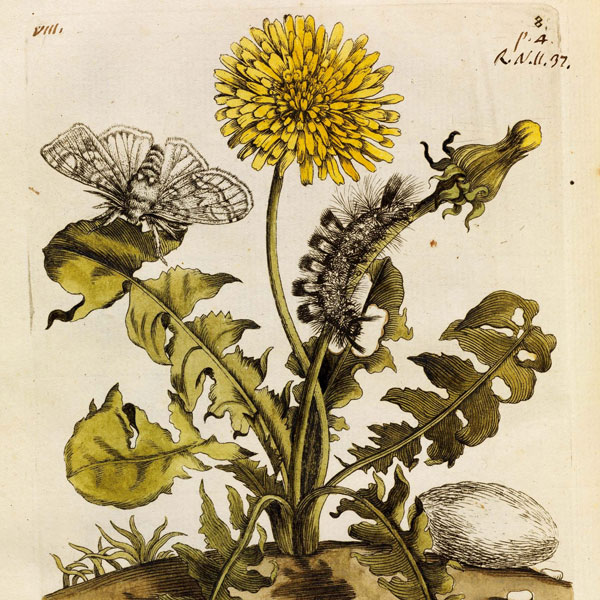
By Linda Wiggen Kraft, Healthy Planet Green & Growing Editor
Gardens can be habitats that support and nurture all stages of a butterfly, moth and insect life. Insects need that habitat during all four seasons. Winter’s habitat of fallen leaves is as necessary as summer’s blossoms. We can thank a 17th century female artist for showing the world the life cycles of butterflies and moths.
Born in Germany in 1647, Maria Sibylla Merian* discovered butterflies and moths have different forms in their life cycles and need specific hosts plants to survive. She was surrounded by a family and community of artists who painted and drew the natural world. Her artist father died when she was three. Her mother remarried a painter and engraver who also captured the natural world, although he and other artists of the time created paintings often more fanciful than accurate. At a young age she helped her stepfather by collecting insects that he painted. She collected eggs, caterpillars, chrysalises and cocoons along with adult butterflies and moths. She had to be extra careful in her collecting for fear of being called a witch and possibly being hung, because she worked with “evil” insects.
Because Maria was female, she was prevented from formal art training and university studies, but she learned to be an artist through her family’s work. As a woman she could only paint in watercolors, not oils. Through her detailed paintings and engravings, she documented that moths and butterflies didn’t “spontaneously generate” from mud and dung as was the prevailing belief. Instead, moths and butterflies lived as eggs, caterpillars, chrysalises and cocoons before emerging as beautiful flying beings, called summer birds in her time.
She carefully observed and through her art documented all these insect’s life stages. In her thirties she published two volumes of her caterpillar engravings and observations titled: The Wondrous Transformation of Caterpillars and their Remarkable Diet of Flowers.
Her most famous collection of engraved paintings came about after her two-year stay in the Dutch Colony Suriname on the east coast of South America. She moved there at age fifty-two as part of a religious community. She observed and painted tropical butterflies, moths, other insects and amphibians. She returned to Amsterdam with her paintings. Many were turned into engravings and became a collection titled Metamorphosis Insectorum Surinamemsium. Maria’s book became famous and popular among collectors. At the time of her death her most famous collection was sold to the Tsar of Russia. Unfortunately, her scientific legacy was dismissed by most after she died.
Recently Maria Sibylla Merian has been recognized in both the scientific and art worlds for her beautiful paintings and engravings, and her first ever recorded observations of the ecological connections of insects and plants.
We can honor the importance of the first ecologist’s discoveries by planting and nurturing native host trees, shrubs and perennials that are the food and shelter for butterflies and moths. These plants will ensure that these lovely “summer birds” will live on.
Linda Wiggen Kraft is a landscape designer of holistic and organic gardens. She is also an artist and creativity workshop leader. Her next art workshop is July . Find out more, subscribe to her blog and Instagram at www.CreativityForTheSoul.com, Call her at 314 504-4266.
*To see some of Maria’s beautiful original engravings and licensed prints, an art gallery in Chicago, Joel Oppenheimer Gallery ,has some. https://www.audubonart.com/shop/category/botanical-art-maria-sibylla-merian-85. Two recommended books are: The Girl Who Drew Butterflies for adults and young adult readers and Summer Birds: The Butterflies of Maria Merian, a children’s picture book. A NY Times article gives her due credit: www.nytimes.com/2017/01/23/science/maria-sibylla-merian-metamorphosis-insectorum-surinamensium.html


